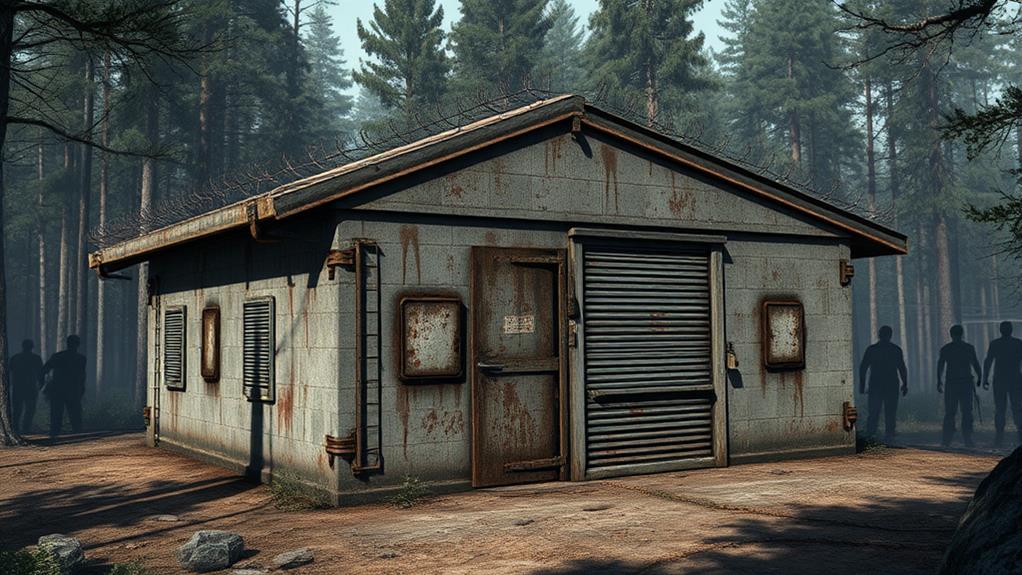
Choosing the right materials for your zombie shelter is essential for maximum protection and durability. Concrete and steel offer unmatched strength and longevity, guaranteeing your shelter can withstand heavy impacts and adverse conditions. Reinforced wood and polycarbonate panels add flexibility and shatterproof properties, making them excellent for fortifying walls and windows. Brick provides added fire resistance and soundproofing, while earthbags are cost-effective and environmentally friendly. Barbed wire around the perimeter creates a formidable barrier against zombies, giving you time to react. These materials collectively guarantee your shelter is secure, durable, and sustainable. Explore further to discover how each material contributes to your safety.
Concrete
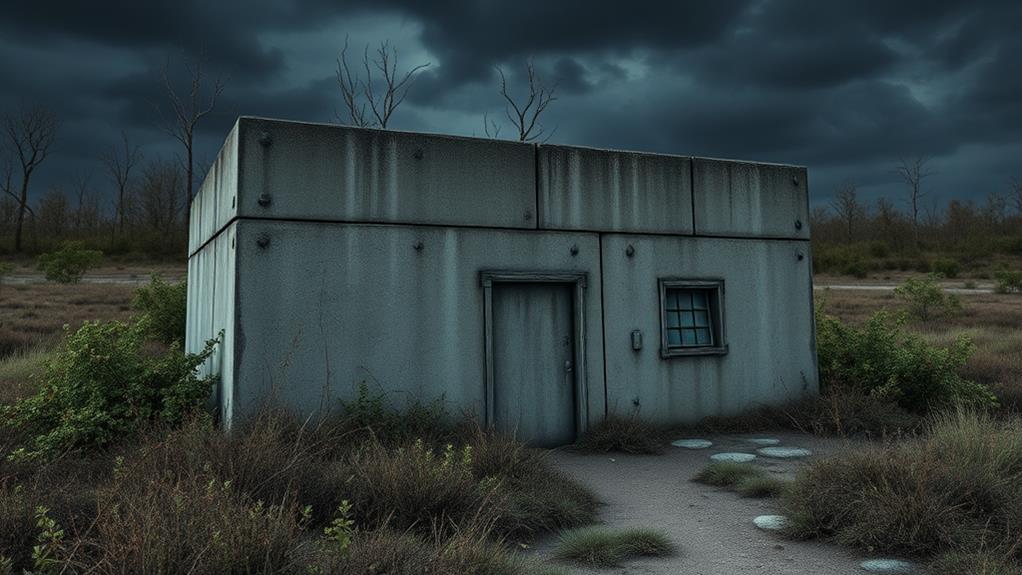
When it comes to building a zombie shelter, concrete is your best friend. Concrete offers unmatched durability and strength. It can withstand heavy impacts, which is essential when you're dealing with relentless zombies trying to break in. Plus, it's fire-resistant, providing an extra layer of protection against any fire hazards that might arise in a chaotic scenario.
Concrete also has excellent longevity. Once you set it, you don't have to worry about frequent repairs or maintenance. This is especially important when resources are scarce, and you need a reliable, long-term solution. Additionally, concrete structures can be easily reinforced to enhance their protective qualities. You can add extra layers or mix in other materials to make it even more formidable against any threats.
Another benefit of concrete is its insulation properties. It helps maintain a stable internal temperature, keeping you comfortable in both hot and cold weather. This is fundamental for maintaining your health and morale in an extended survival situation. Finally, concrete is relatively easy to source and mold, allowing for quick construction, which is essential when time is of the essence. By choosing concrete, you're setting up a strong, reliable foundation for your zombie shelter.
Steel
Steel brings another layer of security to your zombie shelter, thanks to its incredible strength and versatility. This material isn't just strong; it's practically indestructible when it comes to withstanding the relentless force of a horde. Steel's high tensile strength guarantees that your shelter can endure massive impacts without giving in. Whether it's zombies pounding at your door or debris flying during chaotic moments, steel holds up. Additionally, steel’s durability plays a crucial role in maintaining zombie weapons effectively, ensuring your tools and defenses remain reliable during prolonged encounters. Its resistance to wear and corrosion means your shelter’s reinforcements and weaponry won’t easily degrade over time, giving you peace of mind in an unpredictable world. With steel as your ally, you can focus on survival without worrying about structural weaknesses or failing equipment.
When you use steel in your shelter, you're also choosing a material that's highly resistant to corrosion. This means your defenses won't weaken over time due to rust or environmental factors. You can count on steel to maintain its integrity for years, making it a long-term investment in your safety.
Moreover, steel offers great flexibility in design. You can easily mold it into various shapes and sizes, creating customized barriers, doors, and even window reinforcements. This adaptability certifies that every potential entry point is secured and that no corner of your shelter is left vulnerable.
Reinforced Wood
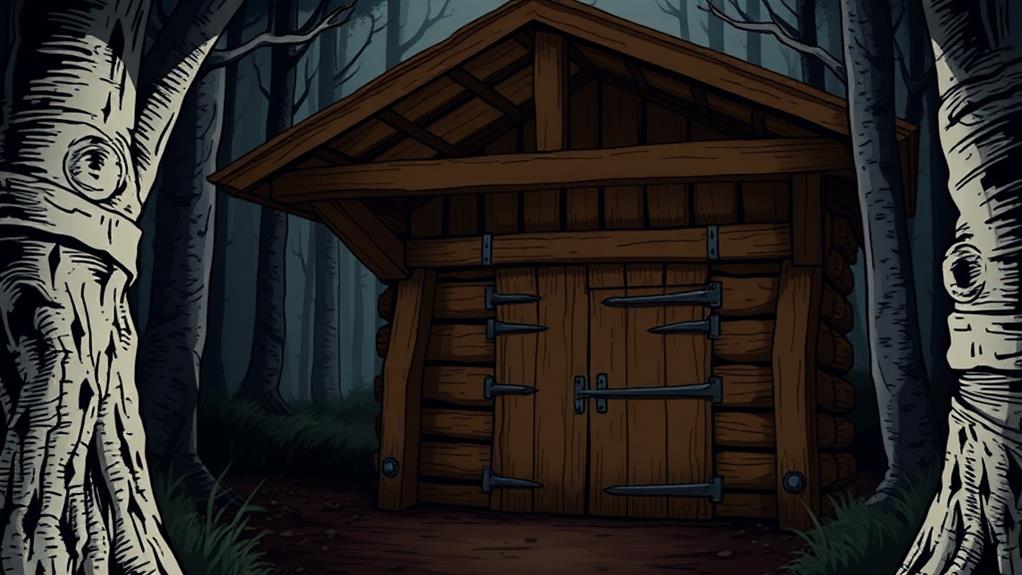
In addition to steel, reinforced wood offers a strong yet flexible option for your zombie shelter. This material combines the natural resilience of wood with modern engineering techniques to enhance its durability. You'll find that reinforced wood can withstand significant force while maintaining a degree of flexibility that pure steel lacks.
Reinforced wood is treated and layered with additional materials such as metal rods or synthetic fibers to increase its strength and longevity. This treatment makes it resistant to impacts, rotting, and even fire to some extent. When building your shelter, you want materials that not only stand up to physical blows but also endure over time.
Here's a quick comparison to help you understand why reinforced wood could be the right choice:
| Feature | Reinforced Wood | Traditional Wood |
|---|---|---|
| Durability | High | Moderate |
| Flexibility | Moderate | High |
| Resistance to Rot | High | Low |
Combining reinforced wood with other sturdy materials like steel can create a balanced, robust structure. This layering approach leverages the best properties of each material, ensuring your shelter is both strong and adaptable in a zombie apocalypse scenario.
Brick
While reinforced wood offers a blend of strength and flexibility for your zombie shelter, brick brings a different set of advantages to the table. First and foremost, brick is incredibly durable and can withstand significant impact, making it an ideal choice for fending off relentless zombie attacks. Its fire-resistant properties add another layer of security, vital in a world where staying safe from both zombies and potential fires is paramount.
Brick also offers excellent insulation, helping to maintain a stable indoor temperature. This means you won't have to worry about extreme weather conditions outside, whether it's the scorching heat or freezing cold. Plus, bricks are low-maintenance and long-lasting, reducing the need for frequent repairs and allowing you to focus on other survival priorities.
Acoustically, bricks are advantageous too. They provide soundproofing, which can be essential when you don't want to attract unwanted zombie attention with everyday noises. Additionally, the aesthetic appeal of brick can't be overlooked; a brick shelter blends in with urban environments, making it less conspicuous.
Polycarbonate Panels
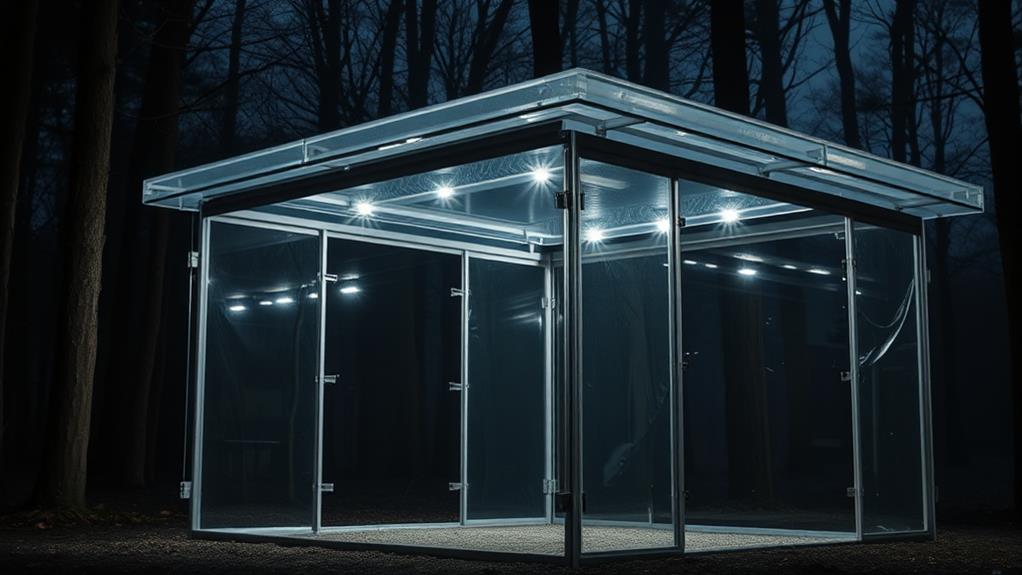
When it comes to building a zombie shelter with a modern twist, polycarbonate panels offer a range of benefits that shouldn't be overlooked. These panels are incredibly strong and durable, making them an ideal choice for fortifying your safe haven. Unlike traditional glass, polycarbonate is virtually shatterproof, ensuring that your windows and walls won't break easily under pressure or assault.
Additionally, polycarbonate panels are lightweight, which makes them easier to install and transport compared to heavier materials like brick or concrete. This means you can quickly set up or modify your shelter as needed without requiring heavy machinery or extensive labor. Their flexibility and ease of use make them perfect for both permanent structures and temporary emergency shelters.
Another advantage is their excellent insulation properties. Polycarbonate panels can help regulate the temperature inside your shelter, keeping it cool in the summer and warm in the winter. This energy efficiency can be vital when resources are scarce.
Lastly, polycarbonate panels are UV-resistant, which helps protect your shelter from harmful sun rays, extending the lifespan of your structure. With these benefits, you're not just building any shelter—you're constructing a resilient, efficient, and modern stronghold.
Earthbags
Polycarbonate panels offer excellent strength and versatility, but for those looking to build a more sustainable and budget-friendly zombie shelter, earthbags present an intriguing alternative. Earthbags, basically sacks filled with dirt, sand, or other local materials, create sturdy and resilient walls that can withstand significant force. They're not only cost-effective but also environmentally friendly, as you can use natural and recycled materials.
You'll find that constructing with earthbags is relatively simple. Just fill the bags, stack them like bricks, and tamp them down to create a solid structure. They don't require specialized skills or tools, making them accessible for almost anyone. Plus, earthbags offer excellent insulation, keeping your shelter warm in the winter and cool in the summer, which is vital for long-term survival.
Additionally, earthbag walls are fire-resistant and bulletproof, providing added layers of protection against both zombies and other threats. You can customize the shape and size of your shelter easily, fitting your specific needs and available space. By choosing earthbags, you're not just building a shelter; you're creating a stronghold that's sustainable, affordable, and incredibly durable.
Barbed Wire
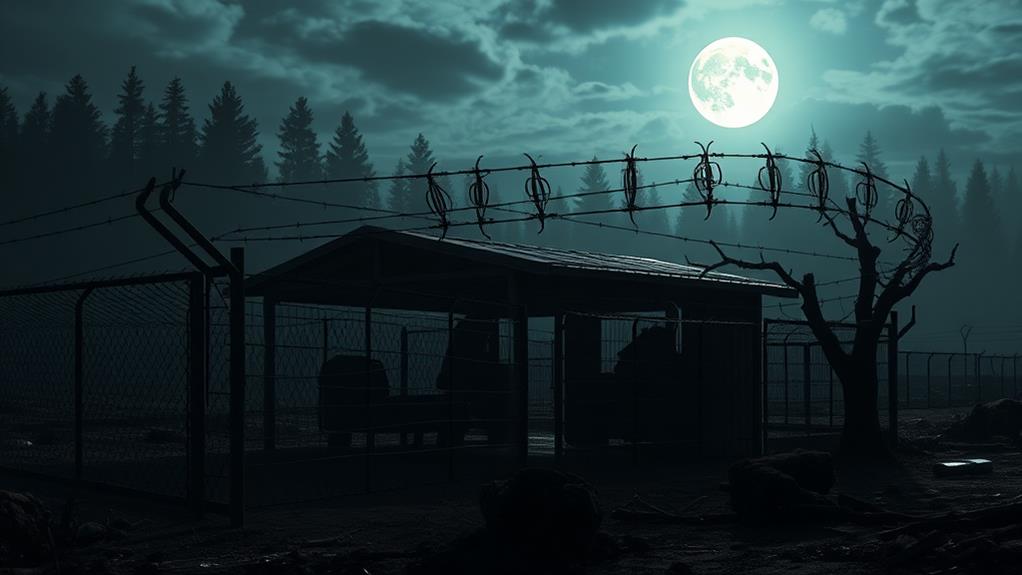
Barbed wire is a crucial component for any effective zombie shelter, offering both a physical barrier and a psychological deterrent. When you install barbed wire around your perimeter, you create an immediate obstacle that slows down and entangles zombies, preventing them from reaching your shelter. It's not just about slowing them down; barbed wire can cause serious injuries to the undead, making it harder for them to continue their relentless pursuit.
You'll also appreciate how barbed wire sends a clear message to any other survivors or potential threats: this area is fortified and not to be trifled with. The sight of barbed wire wrapped around fences, gates, and other strategic points can make would-be intruders think twice before attempting to breach your defenses.
Installation is relatively simple and cost-effective. You can easily wrap barbed wire around existing structures, like fences or barricades, with minimal tools. Just make sure you secure it tightly to prevent any gaps that zombies could exploit. Additionally, barbed wire is durable and requires little maintenance, making it an excellent long-term solution for your shelter's security needs. By incorporating barbed wire, you notably enhance your shelter's defense against the undead.
At a Glance
In your quest for survival, think of your zombie shelter as a fortress of hope. Concrete forms your unyielding foundation, while steel frames your unbreakable resilience. Reinforced wood symbolizes adaptability, and brick represents steadfastness. Polycarbonate panels are your clear vision to the future, and earthbags embody a grounded approach. Barbed wire is your sentinel, warding off chaos. Together, these materials create not just a shelter, but a sanctuary where humanity endures.






